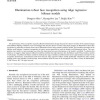Free Online Productivity Tools
i2Speak
i2Symbol
i2OCR
iTex2Img
iWeb2Print
iWeb2Shot
i2Type
iPdf2Split
iPdf2Merge
i2Bopomofo
i2Arabic
i2Style
i2Image
i2PDF
iLatex2Rtf
Sci2ools
PRL
2008
2008
Illumination-robust face recognition using ridge regressive bilinear models
The performance of face recognition is greatly affected by illumination changes because intra-person variation of the captured images under different lighting conditions can be much bigger than the inter-person variation. This paper proposes an illumination-robust face recognition by separating an identity factor and an illumination factor using symmetric bilinear models. The translation procedure in the bilinear model requires a repetitive computation of matrix inverse operations to reach the identity and illumination factors. This computation may result in a non-convergent case when the observation has noisy information or the model is overfitted. To alleviate this situation, we suggest a ridge regressive bilinear model that combines the ridge regression into the bilinear model. This provides a number of advantages: it stabilizes the bilinear model by shrinking the range of identity and illumination factors appropriately and improves the recognition performance. Experimental results...
Bilinear Model | Illumination Factors | Model | PRL 2006 | PRL 2008 |
| Added | 28 Jan 2011 |
| Updated | 28 Jan 2011 |
| Type | Journal |
| Year | 2008 |
| Where | PRL |
| Authors | Dongsoo Shin, Hyung-Soo Lee, Daijin Kim |
Comments (0)

